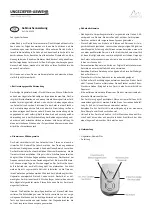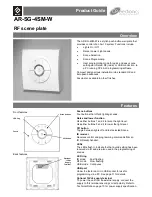
AVENAR panel 8000 | AVENAR panel 2000 |
AVENAR keypad 8000
FPE‑8000‑SPC | FPE‑8000‑PPC | FPE‑8000‑FMR |
FPE‑2000‑SPC | FPE‑2000‑PPC
en
Quick user guide
Bosch Sicherheitssysteme GmbH
Robert-Bosch-Ring 5
85630 Grasbrunn
Germany
www.boschsecurity.com
© Bosch Sicherheitssysteme GmbH, 2020
F.01U.364.479 | 07.2020 | 4.0
The default password is “000000”, please ask your in-
staller to change this password.
Note:
The panel controller may only be operated by
trained personnel. The personal access code (consisting
of user ID and password) must not be made known to
third parties.
DEF
2
1
ABC
3
4
5
6
GHI
JKL
MNO
7
8
9
PQRS
TUV
WXYZ
*
0
#
F2
F3
F1
F1
F1
F1
Fire
0
Control
0
Fault
0
Bypass
0
Status
* Favourites
Bypass off
Multicriteria sensor
Bypass on
Red strobe
Bypass off
Red strobe
Bypass off
Multicriteria sensor
Bypass off
Multicriteria sensor
Bypass off
Multicriteria sensor
If you are already logged on, press
to open
the pre-configured personalized menu. To log off, press
again and confirm with
OK
.
Programmable elements
Function keys
There are three functions keys which are freely program-
mable with frequently used functions of the panel. If a
function key is active it is marked with a green bar. Please
ask your installer to enter the configured function of the
respective key here:
F1
F2
F3
Alarm and fault status LEDs
There are two status LEDs which are programmable for a
self-defined alarm and self-defined fault/disablement.
Please ask your installer to describe the configured device
and status of the respective LED here:
Change time and date
To change the date and time of the panel press
- Further functions - Change date / time
and
enter the correct values via the keypad.
Day- and night mode
The manner in which an incoming alarm is handled de-
pends on whether the system is in day or night mode.
Night mode has the highest security level. Depending on
the configuration, the alarm message is generally transmit-
ted to the fire department without a delay. Signaling
devices and transmission devices to the fire department or
fire protection systems are activated.
If a panel is set to day mode, it is possible to delay the
transmission of the first alarm signal to prevent false
alarms. Therefore an alarm must be acknowledged within
a certain time. The transmission device to the fire depart-
ment is not activated in this case. During the delay, the
cause of the alarm message can be checked within a con-
figured investigation time to ensure it is correct.
If the investigation time passes by without any further user
input (alarm trigger or reset) the transmission to the fire
department is activated automatically.
The following symbols on the status bar show which mode
the panel is switched to. In the case of networked panels,
a night-/day combination icon is displayed on panels in
night mode, if at least one panel in the network is in day
mode.
Standalone
Network
Night mode
Panel is in
night mode
All networked panels
in the network scope
are in night mode
Day mode
Panel is in
day mode
-
Night-/day
combination
-
Panel is in night
mode but at least
one other panel in
the network scope is
in daymode
To switch between day- and night mode press the current
symbol in the status bar and select either
Switch to day
mode
or
Switch to night mode
.
Fire
0
Control
0
Fault
0
Bypass
0
Status
Switching off internal buzzer
DEF
2
1
ABC
3
4
5
6
GHI
JKL
MNO
7
8
9
PQRS
TUV
WXYZ
*
0
#
F2
F1
F3
F1
F1
F1
F2
F2
F2
F3
F3
F3
Fire
2
Control
2
Fault
0
Bypass
0
Status
Bypass
Block
Diagnostics
Maintenance
Configuration
Switch to day mode
Further functions
Control
Monitoring
Reset
* Level 3 logged in
1. Press
to temporarily switch off the in-
ternal buzzer.
Display history
In the history log, all data about particular events or
device types is stored sorted by date and time. To display
only particular data, filters can be set.
To show the history log press
-
Diagnostics
-
History log
.
Select language
Press
to access the main menu. Press “1” on
the alphanumeric keypad. Confirm the appearing query
with
OK
and select the required language from the list.
Further information
For detailed information on the operation of the fire panel
please refer to www.boschsecurity.com.
11 |
12 |
13 |
14 |
15 |
16 |
17 |
18 |


































